
For many people, Normandy -- province in North-Western France -- conjures up images of the massive armada that descended upon its shores on June 6, 1944 to drive the Nazis out of continental Europe.
However, Normandy is a lot more than just that. In Normandy, the traveller can find lovely little seaside towns, verdant valleys full of apples, windswept beaches, ruined chateaus, and beautiful farms, each within a few hours' drive of the other.
Normandy's natural beauty has made it a favoured haunt for some of the world's most lauded impressionists, composers, and writers. Once you have seen Normandy, it is not hard to understand why.
Its role in European history does not begin with World War II either. It was a Norman King who invaded Britain in 1066 and started the dynasty that continues to this date, and Normandy was fought over by the British and the French for hundreds of years thereafter.
There is no better way to get to know Normandy and its people than by driving through its back roads. Oh, and speaking a bit of French might help, too, though miming worked quite well for me!
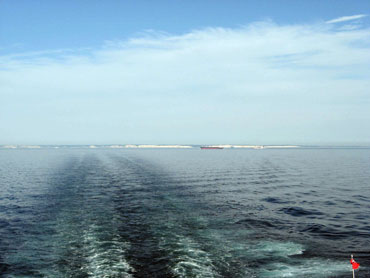
To visit Normandy, Indian citizens -- excepting those resident in the Schengen area (this does not include the UK) -- require a Schengen visa. A Schengen visa may be obtained quite easily from a French mission in your country of residence.
There are no direct flights from India to Normandy. But it is very easy to fly to Paris, and to then get to Normandy's major cities -- Rouen, Caen, and Cherbourg - by rail (www.sncf.fr).
Another alternative -- one I couldn't recommend highly enough -- is to take a ferry to France from the UK, and then drive through Normandy (https://www.directferries.co.uk). The main ferry ports in the UK are Dover (which is the easiest to get to from London), Portsmouth, and Plymouth. You can take the ferry to Dunkerque or Calais, and drive down from there, or take a ferry directly to Caen or Cherbourg.
Taking a ferry is quite a unique experience, and is far removed from the stresses and strains of flying when brown. As you load your car on to the ship, you cannot help but marvel at the logistics involved in ferrying cars and even 18-wheel trucks across the English channel several times a day. But all of that pales into insignificance when you stand on the open deck and catch a glimpse of the iconic white cliffs of Dover as the ship sails away from the UK.
The ferry is extremely comfortable, and there's plenty to do during the journey . You can watch the traffic on what is one of the busiest waterways in the world, relax over a cup of coffee and a snack, the prices for which are surprisingly un-airport-like, in one of the ferry's many restaurants, or indulge in some duty-free shopping.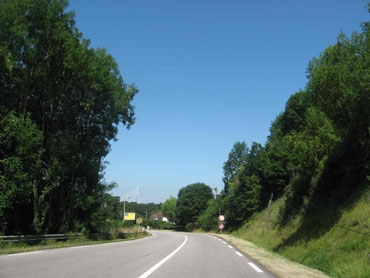
While you could take a train and get around Normandy, the best way to get to know the place is to drive down its back roads.
Renting a car is not particularly hard, and may work out significantly cheaper if you're travelling in a group of two or more people. Websites such as Expedia can help you compare prices from several different car rental providers. Shop around! You're sure to stumble upon something quite affordable.
If you hold an Indian driving licence, you will require an International Driving Permit (which usually comes in both English and French) to drive in France. This may be obtained either from the RTO or from the AA (if you are a member). Holders of American and European licences do not require an international driving permit.
Roads in France come in three flavours: Autoroutes, Route Nationales, and Minor Roads (prefixed with a 'D'). It is the last of these that I would recommend to a traveller who wishes to explore Normandy in all its splendour. These roads take you through a succession of picturesque Norman villages where you might want to stop off for an occasional coffee (or crepe).
Do remember that the French drive on the right side of the road, and are unlikely to take kindly to people going clockwise around their roundabouts.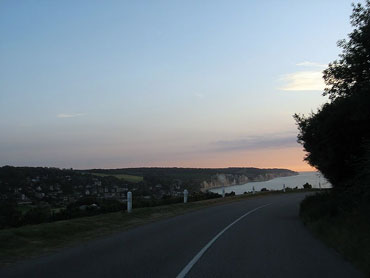
There's a plethora of options when it comes to finding a place to bed for the night, ranging from cheap and adventurous hostels to expensive and luxurious hotels. However, it is my opinion that nothing can quite beat a pitch in a camp site, especially in the summer.
Camping in the great outdoors (20-40 euros per night, https://www.campingfrance.com/UK) may strike the reader as rather rough and unsuitable for families, but nothing could be further from the truth, particularly in France. French camp sites have star ratings, and camp sites with three or four stars come with everything that a person might need, from clean toilets all the way through to swimming pools. But if you like your creature comforts and don't fancy pitching your own tent, you could look at renting a mobile home (mobile homes typically have a minimum let period of a week).
One point to remember is that as a camper, you might want to practise zipping and unzipping your tent very quickly, as you might otherwise end up with a few wee guests from the insect world with a penchant for feeding off your blood. Mosquito repellent helps too, when reasoning with the unbidden guests to leave fails.
Camp sites are often located outside towns (fresh air and space are often rather scarce in the cities), and may therefore not be feasible if you aren't driving. A budget option in this case may be to stay in a youth hostel (15-30 euros per night, https://www.hihostels.com) contrary to its name, youth isn't a prerequisite!
A third option is a rural G te (https://www.holiday-gites.com/), which are sometimes within working farms.
Note: I have been reliably informed that lucky travellers may get to milk the cows in the farm!

Dieppe, once a tiny fishing settlement, grew to become a seaside resort popular among the English artist fraternity in the 19th century. The celebrated Irish writer and aesthete, Oscar Wilde, spent the last years of his life -- following his incarceration from 1895-97 for 'indecency' -- in Dieppe, and is buried in the city. Dieppe's promenade, filled with restaurants and cafes, are a delight, as are the white cliffs and the marina. Don't miss out on the opportunity to gorge on some delicious seafood by the promenade.
Honfleur is another seaside resort marginally south of Dieppe. Saturday, when Honfleur hosts a massive street market, is the best day of the week to visit. There are few better ways to while away an afternoon than to buy lunch from the street market, eat it on a shady bench in the nearby public garden, and walk it off along Honfleur's narrow streets.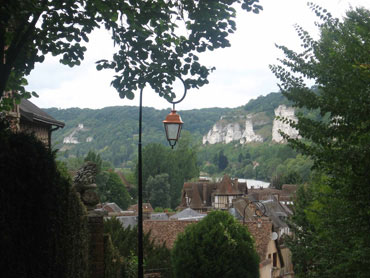
Unless one were to take the instance of my art teacher violently flinging my painting book out of her office in 1999, I have had little in common with art. However, this did not stop me from standing slack-jawed in awe when confronted with the lovely Norman scenery and the paintings they inspired.
Normandy has played host to several impressionists over the years. The great Claude Monet lived in Giverny, a little village that now appears to feed off the legacy of its late resident. Giverny consists of a main street of breathtaking beauty and little else. However, this is no reason to give it a miss-in-the-baulk, especially as you'd then be missing to visit Claude Monet's beautifully landscaped gardens, and the exhibitions of more contemporary artists.
About 15 km from Giverny is picturesque Les Andelys, where a traveller tired out by impressionism -- and the pricey restaurants making their living out of impressionism charge -- can retire for the day. The town is dominated by the imposing Chateau-Gaillard, a fort that has played a major role in Franco-British history and inspired the famous Les Bouches inutiles (Useless mouths) painting by Francis Tattegrain.
Honfleur, about which I waxed eloquent in the previous slide, has its slice of impressionist history too. Eug ne Boudin lived close by all his life, and is today remembered at the Eug ne Boudin museum (https://en.ot-honfleur.fr/Eugene-Boudin-Museum,0,0,34.html, closed Tuesdays).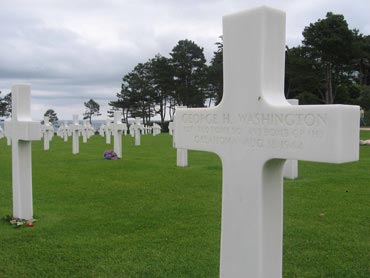
Say what one may of the splendour, beauty, and riches of the rest of Normandy, it is impossible to visit it without devoting some time to visiting the famed invasion beaches.
A bit of history: At 0600 hours On June 6 1944, the largest armada the world had ever seen descended upon the beaches of Normandy, thereby beginning the process of beating the Nazis out of France and bringing an end to the second World War in Europe. Many of these 100,000 troops American, Canadian, British, and (Free) French never made it out of the beaches, having been cut down by the bullets of the German defenders.
Omaha Beach in the American sector was the bloodiest of the invasion beaches, so much so that it is often referred to as Bloody Omaha. The beach was once called Plage d'Or (The Golden Beach), and has now been renamed after the American codeword for it as a mark of respect for the fallen. It is impossible to not be profoundly affected when you behold "Les Braves" (Anilor Banon, 2005) a giant stainless steel monument to the bravery of American troops in Omaha.
A stone's throw away from the beach is the Normandy American Cemetery and Memorial. It is a very sombre place with its miles of gliterring white headstones. Even as an Indian with no historical ties to the war in Europe or to America, I could not help but feel pensive and the slightest bit depressed. But it is worth it and more if it can make humanity rise up as a collective to shout, "Never again!".
There are other beaches along the coast, including the Juno and Sword beaches where British and Canadian troops fought, as well as a war museum a few miles inland in Falais.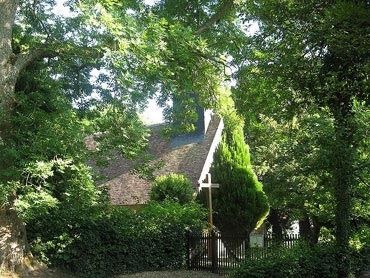
As this travelogue has been all about discovering Normandy by way of its back roads, there is no better way to end it than with a suggested itinerary (three days).
Day 1:
The road trip starts at Rouen (easily reached from Dunkerque, Calais, or Paris). From Rouen, drive on to Lyons-La-Foret, a village that could well have been built for the express purpose of embedding it in picture postcards. Then, drive along the back roads via Neufchatel-en-Bray towards Dieppe where you can treat yourself to some of the best fresh seafood imaginable. Following a full dinner, set your tent up in Varengeville-sur-Mer (https://www.campinglemarqueval.com/).
Day 2:
Start Day 2 bright and early with a refreshing coffee and croissant, and drive towards Honfleur, avoiding the highways. As you approach Honfleur, look to your right and be amazed by the architectural magnificence of the Pont du Normandie (Norman bridge). Spend the afternoon in Honfleur, walking along its cobbled streets, stopping for a lovely bite to eat at a bistro facing the sea. If you're feeling hot, it might be a good idea to stop at Trouville-sur-Mer and luxuriate on the beach. This is an idea that might be of particular interest to hot-blooded males among the readers. Spend the early evening driving through the Route du Cidre, stopping off at one of the farms to buy a few bottles of divine pear cider. Stop for the day at a campsite near the D-Day landing beaches (https://www.camping-la-roseraie.fr/-English-.html).
Day 3:
Visit Omaha beach, and ponder the brutality of humankind at the American cemetery. Spend the late morning in Bayeux, and pay a visit to the magnificent cathedral. After lunch, drive along the back roads to Giverny; apart from Claude Monet's magnificent garden, you might stumble upon some breathtaking (and free) exhibits by contemporary artists. End the day after climbing up the cliff at Les Andelys to see Chateau Gaillard the views out to the town and the surrounding countryside from the Chateau are well worth it. Stay the night at a camp site across the road from the Chateau itself (https://www.camping-troisrois.com/).